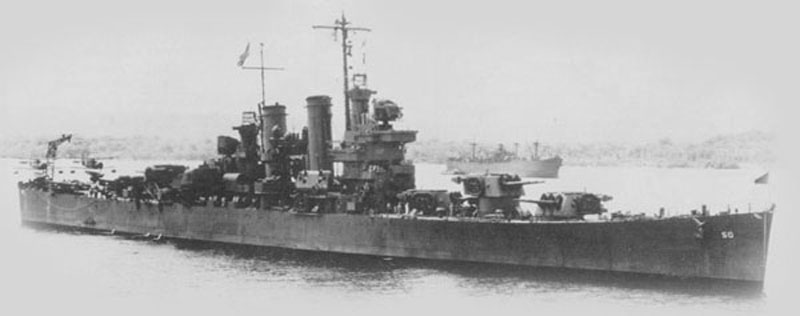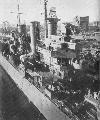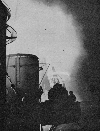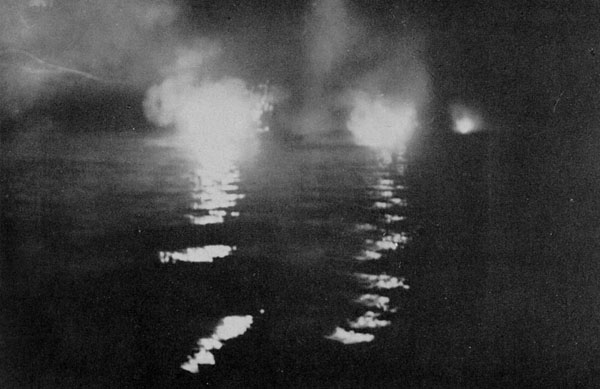"The Fightin'est Ship"

At anchor in the South Pacific prior to the Guadalcanal Battles

| The USS Helena was a modified Brooklyn Class Cruiser, officially referred to as a St. Louis class. They were built to counter the Japanese Mogami class, and are unique among US Cruisers in there five turret main gun arrangement. The St. Louis class differs in that the superstructure is more compact, and the secondary arrangement consists of 8 5"-38 cal. dual purpose guns in four twin turrets. |  |
| The Helena was at Pearl Harbor on the 7th of December and suffered damage from a single aerial torpedo that passed under the Ogalala in the attack. The crew of the Helena promptly achieved watertight and was able to keep her afloat. Another bomb fell right between them and ruptured the hull of the Ogalala and she capsized. The Helena was able to keep other attackers away with aggressive Anti-Aircraft fire. The Helena was partially repaired in the drydock next to the one where the USS Pennsylvania was damaged along with Cassin and Downes. |  |
| She was then sent to Mare Island in San Francisco for a major overhaul. This is where the Helena received her new SG radar and had her forward superstructure dramatically reduced giving her a unique appearance among other ships in her class. | |
| The Helena first reported to the South Pacific escorting a detachment of Sea Bees and an aircraft carrier rushing planes to the South Pacific. For a time she escorted ships to and from Guadalcanal from Espiritu Santo, before joining the task force centered around the Carrier Wasp. The Helena was with the ill fated carrier when on 15 September 1942, she was torpedoed while operating in torpedo junction in support of the Marines on Guadalcanal. The Helena stood by to take on almost 400 survivors from the Wasp. |  |
| The Helena's first chance to strike back came at the Battle of Cape Esperance as part of Task Force 64 where the US Navy successfully crossed the Japanese Navy's "T". It was the Helena with her superior radar that first sighted the enemy and helped Admiral Scott maneuver into position to deliver a devastating fire on the oncoming enemy ships. The Japanese were caught off guard and when they realized what they where sailing into it was too late. Admiral Scott's flagship was the San Francisco which had only fire control radar to guide her and this was only useful at close range so his battle picture was somewhat blurry. Never the less the when the Americans opened fire they were able to bring all there guns to bear. The Japanese were only able to fire with their forward guns. The Helena was first to open fire and engaged two targets eventually helping to sink the Furataka, and Fubuki. The Japanese sustained heavy damage to the heavy cruiser Aoba and Destroyer Hatsuyuki, with light damage to Heavy Cruiser Kinugasa. The Americans lost Destroyer Duncan, and Light Cruiser Boise was nearly sunk, retiring with heavy damage to her forward quarters. CA Salt Lake City, and Destroyers Farenholt and McCalla suffered light damage with the Helena unscathed. | |
| Helena had a close call on the night of 20 October, while patrolling
between Espiritu Santo and San
Cristobal. Lookout Lt. Sam Leiman spotted the wake of a torpedo. "Torpedo wake on the port bow!" he yelled "Emergency right rudder, full speed ahead! Sound General Quarters!" The Helena heeled over and the torpedo passed by the bow exploding and spraying shrapnel over the forward deck. 1 |
|
| Helena was part of the escort for the Transports bring reinforcements into Guadalcanal and on the 12th of November helped shoot down eight of the Betty Bombers attacking the ships. Reports from coast watchers and reconnaissance aircraft were of a large force of enemy ships approaching from the north. Since there were no transports it was evident that this force was intent on breaking up the landing and destroying the American ships in the area. When it was decided to withdraw the Transports, the Helena and the other ships saw them safely out of danger. Then late in the evening of the 12th they reversed course with the twelve other ships of Task Force 67.4 and headed back into the waters of Iron Bottom Sound. Though up against a superior force that included two Battleships, the Helena and the other ships were able to stop the enemy from bombarding the airfield and troops ashore. | |
| But at heavy cost the US lost destroyers Barton, Laffey, Cushing, and
Monssen. The Cruiser Atlanta was so heavily damaged that she had to be
scuttled, Admiral Scott lost his life on this cruiser. The Portland had
her stern nearly blown off and had to be helped into the anchorage at Tulagi.
The Flag ship Heavy Cruiser San Francisco was heavily damaged but able
to steam to safety, though a direct hit killed her Captain and Admiral
Callaghan.
The Juneau took a torpedo that broke her keel and left her barely able to sail away. In addition the other ships had sustained various levels of damage. The Helena seemed to be the lucky one taking only minor hits, when the remaining ships withdrew Captain Gilbert Hoover found himself in charge of a force of ships, badly beat up and lucky to come out with what few ships were left. The Japanese Navy was not done with them yet, though as a lone Submarine let loose a savo of torpedo's aimed at the San Francisco that missed and found the unfortunate Juneau instead. The sailors aboard the Helena were horrified to see the tremendous blast that must have been the magazine exploding and when the smoke settled there was no trace of the Juneau. |
 |
| The ships that suffered the most damage went home for repairs, but the Helena was quickly patched up and returned to fight on bombarding Japanese positions on New Georgia during January 1943. Further bombardments took place at Munda and Vila Stanmore, leveling vital supply concentrations and gun emplacements. One of her float planes shared in the sinking of Japanese submarine RO-102, on February 11, 1943. She stayed in the waters around Guadalcanal until February, when she went to Sydney, Australia, for an overhaul. She was back in time to participate in bombardments of New Georgia, soon to be invaded. | |

Notice how the Helena is silhouetted against the blackness by the bright flash of her guns blazing away. |
|
| Her last shore bombardment came at Kula Gulf when she blasted the forces on shore with her 15 "six inch machine guns", called that for the incredible rate of fire that the crew was able to achieve. The Helena had helped support the landing of US Troops and now was called to battle a force of Japanese Destroyers approaching their ships. The ship fired continuously at the Japanese Destroyers, which proved to be her undoing, for the Americans had yet to adopt the use of flash less powder, and the muzzle flash proved to be a perfect aiming point for the Long Lance torpedo's. One torpedo slammed into the Helena followed by two more within three minutes. All at once the cruiser began flooding and jack knifed with the read going under almost immediately. Only the bow remained above water, but the sailors seeking refuge there soon found that the bow was still a target. The remaining American ships managed to fend off the Japanese ships and rescue operations began with the escorting Destroyers picking up as many survivors as possible. Returning several days later many more were saved in a daring mission that sent our destroyers further up the slot than they had ever operated. 166 men that had evaded capture by Japanese land forces helped by friendly natives and coast watchers were safely returned back to base. | |
| The USS Helena was the first ship to receive the Navy Unit
Commendation. Her actions in the Battles of Cape Esperance, Guadalcanal,
and Kula Gulf were named in the citation. She also earned the Asiatic
Pacific Area Campaign medal with seven Stars. She was the Fightin'est
Ship.
LINKS:
|
|
